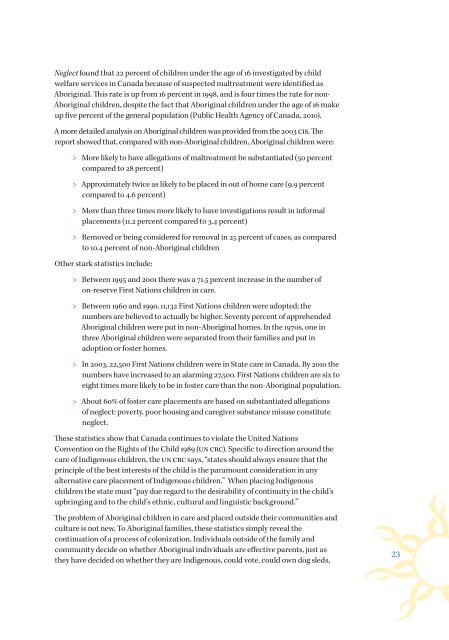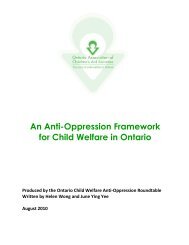English - Ontario Association of Children's Aid Societies
English - Ontario Association of Children's Aid Societies
English - Ontario Association of Children's Aid Societies
You also want an ePaper? Increase the reach of your titles
YUMPU automatically turns print PDFs into web optimized ePapers that Google loves.
Neglect found that 22 percent <strong>of</strong> children under the age <strong>of</strong> 16 investigated by child<br />
welfare services in Canada because <strong>of</strong> suspected maltreatment were identified as<br />
Aboriginal. This rate is up from 16 percent in 1998, and is four times the rate for non-<br />
Aboriginal children, despite the fact that Aboriginal children under the age <strong>of</strong> 16 make<br />
up five percent <strong>of</strong> the general population (Public Health Agency <strong>of</strong> Canada, 2010).<br />
A more detailed analysis on Aboriginal children was provided from the 2003 CIS. The<br />
report showed that, compared with non-Aboriginal children, Aboriginal children were:<br />
> > More likely to have allegations <strong>of</strong> maltreatment be substantiated (50 percent<br />
compared to 28 percent)<br />
> > Approximately twice as likely to be placed in out <strong>of</strong> home care (9.9 percent<br />
compared to 4.6 percent)<br />
> > More than three times more likely to have investigations result in informal<br />
placements (11.2 percent compared to 3.4 percent)<br />
> > Removed or being considered for removal in 25 percent <strong>of</strong> cases, as compared<br />
to 10.4 percent <strong>of</strong> non-Aboriginal children<br />
Other stark statistics include:<br />
> > Between 1995 and 2001 there was a 71.5 percent increase in the number <strong>of</strong><br />
on-reserve First Nations children in care.<br />
> > Between 1960 and 1990, 11,132 First Nations children were adopted; the<br />
numbers are believed to actually be higher. Seventy percent <strong>of</strong> apprehended<br />
Aboriginal children were put in non-Aboriginal homes. In the 1970s, one in<br />
three Aboriginal children were separated from their families and put in<br />
adoption or foster homes.<br />
> > In 2003, 22,500 First Nations children were in State care in Canada. By 2010 the<br />
numbers have increased to an alarming 27,500. First Nations children are six to<br />
eight times more likely to be in foster care than the non-Aboriginal population.<br />
> > About 60% <strong>of</strong> foster care placements are based on substantiated allegations<br />
<strong>of</strong> neglect: poverty, poor housing and caregiver substance misuse constitute<br />
neglect.<br />
These statistics show that Canada continues to violate the United Nations<br />
Convention on the Rights <strong>of</strong> the Child 1989 (UN CRC). Specific to direction around the<br />
care <strong>of</strong> Indigenous children, the UN CRC says, “states should always ensure that the<br />
principle <strong>of</strong> the best interests <strong>of</strong> the child is the paramount consideration in any<br />
alternative care placement <strong>of</strong> Indigenous children.” When placing Indigenous<br />
children the state must “pay due regard to the desirability <strong>of</strong> continuity in the child’s<br />
upbringing and to the child’s ethnic, cultural and linguistic background.”<br />
The problem <strong>of</strong> Aboriginal children in care and placed outside their communities and<br />
culture is not new. To Aboriginal families, these statistics simply reveal the<br />
continuation <strong>of</strong> a process <strong>of</strong> colonization. Individuals outside <strong>of</strong> the family and<br />
community decide on whether Aboriginal individuals are effective parents, just as<br />
they have decided on whether they are Indigenous, could vote, could own dog sleds,<br />
23

















